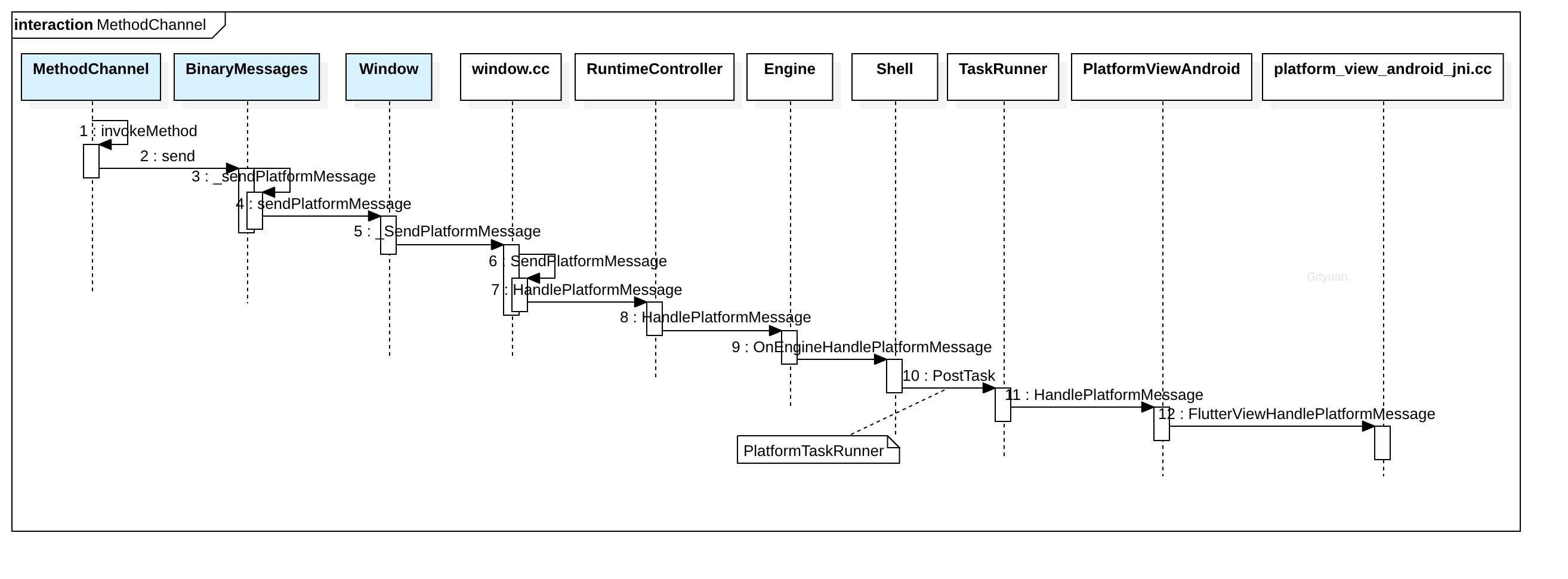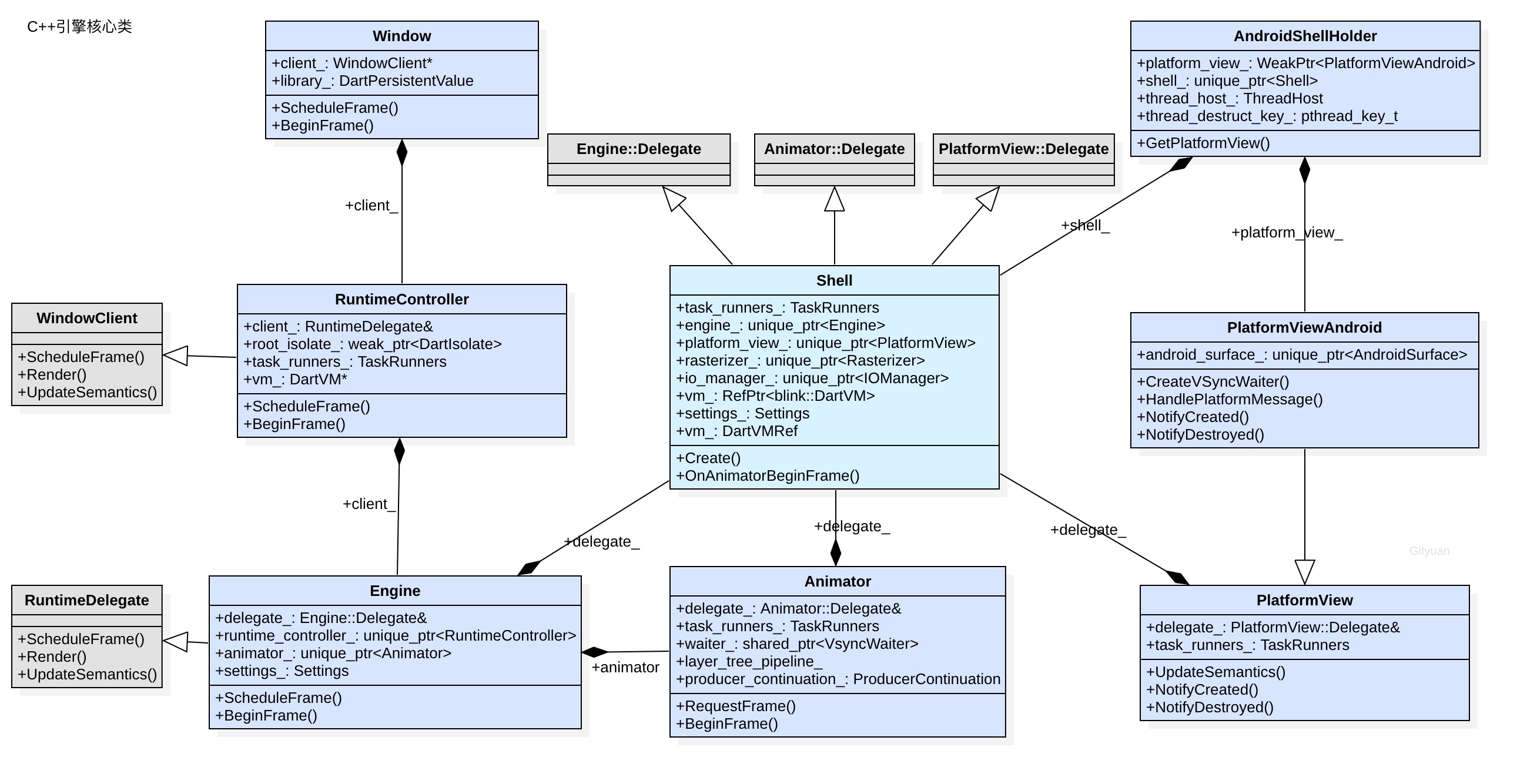基于Flutter 1.5,从源码视角来深入剖析flutter的channel,相关源码目录见文末附录
一、概述
Flutter 官方提供了一种 Platform Channel 的方案,用于 Dart 和平台之间相互通信。
核心原理:
- Flutter应用通过Platform Channel将传递的数据编码成消息的形式,跨线程发送到该应用所在的宿主(Android或iOS);
- 宿主接收到Platform Channel的消息后,调用相应平台的API,也就是原生编程语言来执行相应方法;
- 执行完成后将结果数据通过同样方式原路返回给应用程序的Flutter部分。
整个过程的消息和响应是异步的,所以不会直接阻塞用户界面。
1.1 流程图

FlutterViewHandlePlatformMessage()方法会调用到Java层的FlutterJNI.handlePlatformMessage()方法。

1.2 Channel类说明
1) Flutter提供了三种不同的Channel:
- BasicMessageChannel:传递字符串和半结构化数据
- MethodChannel:方法调用
- EventChannel:数据流的通信
2) 方法编解码MethodCodec有两个子类:
- StandardMethodCodec
- JSONMethodCodec
3) 消息编解码MessageCodec有4个子类:
- StandardMessageCodec
- StringCodec
- JSONMessageCodec
- BinaryCodec
4) BinaryMessages
_handlers的数据类型为map,其中以MethodChannel的name为key,以返回值为Future
//待完善
1.3 实例
以官方提供的Android平台获取电池电量的实例,有Flutter端和Android端两部分代码。
Flutter端代码:
class _HomePageState extends State<HomePage> {
//创建MethodChannel [见小节2.1]
static const platform = const MethodChannel('samples.flutter.io/battery');
Future<void> _getBatteryLevel() async {
try {
//调用相应通道的方法 [见小节2.2]
int batteryLevel = await platform.invokeMethod('getBatteryLevel');
} on PlatformException catch (e) {
...
}
}
}
Android端代码:
public class MainActivity extends FlutterActivity {
private static final String CHANNEL = "samples.flutter.io/battery";
public void onCreate(Bundle savedInstanceState) {
super.onCreate(savedInstanceState);
//创建方法通道 [见小节4.1]
new MethodChannel(getFlutterView(), CHANNEL).setMethodCallHandler(
new MethodCallHandler() {
public void onMethodCall(MethodCall call, Result result) {
if (call.method.equals("getBatteryLevel")) {
//调用android端的BatteryManager来获取电池电量信息
int batteryLevel = getBatteryLevel();
if (batteryLevel != -1) {
//将函数执行的成功结果回传到Flutter端
result.success(batteryLevel);
} else {
//将函数执行的失败结果回传到Flutter端
result.error("UNAVAILABLE", "Battery level not available.", null);
}
} else {
result.notImplemented();
}
}
});
}
}
二、Dart层
2.1 MethodChannel初始化
[-> lib/src/services/platform_channel.dart]
class MethodChannel {
//[见小节2.1.1]
const MethodChannel(this.name, [this.codec = const StandardMethodCodec()]);
final String name;
final MethodCodec codec;
}
默认用的是标准方法编解码器StandardMethodCodec
2.1.1 StandardMethodCodec初始化
[-> lib/src/services/message_codecs.dart]
class StandardMethodCodec implements MethodCodec {
//[见小节2.1.2]
const StandardMethodCodec([this.messageCodec = const StandardMessageCodec()]);
final StandardMessageCodec messageCodec;
}
2.1.2 StandardMessageCodec初始化
[-> lib/src/services/message_codecs.dart]
class StandardMessageCodec implements MessageCodec<dynamic> {
const StandardMessageCodec();
}
2.2 MethodChannel.invokeMethod
[-> lib/src/services/platform_channel.dart]
class MethodChannel {
Future<T> invokeMethod<T>(String method, [ dynamic arguments ]) async {
//[见小节2.3]
final ByteData result = await BinaryMessages.send(name,
codec.encodeMethodCall(MethodCall(method, arguments)),
);
...
final T typedResult = codec.decodeEnvelope(result);
return typedResult;
}
}
该方法主要功能:
- 创建MethodCall对象[小节2.2.1];
- 通过StandardMethodCodec的encodeMethodCall将MethodCall转换为ByteData数据类型[小节2.2.2];
- 然后调用BinaryMessages的send来发送消息[小节2.3]
- 最后,decodeEnvelope来解码结果
2.2.1 MethodCall初始化
[-> lib/src/services/message_codec.dart]
class MethodCall {
const MethodCall(this.method, [this.arguments]);
final String method; //方法名,非空
final dynamic arguments;
}
2.2.2 encodeMethodCall
[-> lib/src/services/message_codecs.dart]
class StandardMethodCodec implements MethodCodec {
ByteData encodeMethodCall(MethodCall call) {
//创建一个用于写的buffer [见小节2.2.3]
final WriteBuffer buffer = WriteBuffer();
//调用StandardMessageCodec将数据写入buffer
messageCodec.writeValue(buffer, call.method);
messageCodec.writeValue(buffer, call.arguments);
return buffer.done();
}
}
2.2.3 WriteBuffer初始化
[-> lib/src/foundation/serialization.dart]
class WriteBuffer {
WriteBuffer() {
_buffer = Uint8Buffer();
_eightBytes = ByteData(8);
_eightBytesAsList = _eightBytes.buffer.asUint8List();
}
Uint8Buffer _buffer;
ByteData _eightBytes;
Uint8List _eightBytesAsList;
ByteData done() {
final ByteData result = _buffer.buffer.asByteData(0, _buffer.lengthInBytes);
_buffer = null;
return result;
}
...
}
2.3 BinaryMessages.send
[-> lib/src/services/platform_messages.dart]
class BinaryMessages {
static Future<ByteData> send(String channel, ByteData message) {
final _MessageHandler handler = _mockHandlers[channel];
if (handler != null)
return handler(message);
//[见小节2.4]
return _sendPlatformMessage(channel, message);
}
}
_mockHandlers是用于调试的。
2.4 BinaryMessages._sendPlatformMessage
[-> lib/src/services/platform_messages.dart]
static Future<ByteData> _sendPlatformMessage(String channel, ByteData message) {
//[见小节2.4.1]
final Completer<ByteData> completer = Completer<ByteData>();
//[见小节2.5]
ui.window.sendPlatformMessage(channel, message, (ByteData reply) {
try {
//[见小节6.6]
completer.complete(reply);
} catch (exception, stack) {
...
}
});
return completer.future;
}
2.4.1 Completer初始化
[-> third_party/dart/sdk/lib/async/future.dart]
factory Completer() => new _AsyncCompleter<T>();
2.4.2 _AsyncCompleter初始化
[-> third_party/dart/sdk/lib/async/future_impl.dart]
class _AsyncCompleter<T> extends _Completer<T> {
void complete([FutureOr<T> value]) {
future._asyncComplete(value);
}
}
abstract class _Completer<T> implements Completer<T> {
final _Future<T> future = new _Future<T>();
void complete([FutureOr<T> value]);
}
2.5 window.sendPlatformMessage
[-> flutter/lib/ui/window.dart]
class Window {
void sendPlatformMessage(String name, ByteData data,
PlatformMessageResponseCallback callback) {
final String error =
_sendPlatformMessage(name, _zonedPlatformMessageResponseCallback(callback), data);
if (error != null)
throw new Exception(error);
}
//[见小节3.1]
String _sendPlatformMessage(String name,
PlatformMessageResponseCallback callback,
ByteData data) native 'Window_sendPlatformMessage';
}
2.5.1 window._zonedPlatformMessageResponseCallback
[-> flutter/lib/ui/window.dart]
static PlatformMessageResponseCallback _zonedPlatformMessageResponseCallback(
PlatformMessageResponseCallback callback) {
//储存在注册回调所在的zone区域
final Zone registrationZone = Zone.current;
return (ByteData data) {
registrationZone.runUnaryGuarded(callback, data);
};
}
接下来执行_sendPlatformMessages,这是一个native方法,会调用到Flutter引擎层。
三、引擎层
3.1 _SendPlatformMessage
[-> flutter/lib/ui/window/window.cc]
void _SendPlatformMessage(Dart_NativeArguments args) {
tonic::DartCallStatic(&SendPlatformMessage, args);
}
void Window::RegisterNatives(tonic::DartLibraryNatives* natives) {
natives->Register({
{"Window_defaultRouteName", DefaultRouteName, 1, true},
{"Window_scheduleFrame", ScheduleFrame, 1, true},
{"Window_sendPlatformMessage", _SendPlatformMessage, 4, true},
...
});
}
Window.dart中的_sendPlatformMessage()最终对应于引擎层中window.cc的_SendPlatformMessage()方法,为了更好理解引擎中的调用关系,见如下Enggine核心类图

3.2 SendPlatformMessage
[-> flutter/lib/ui/window/window.cc]
Dart_Handle SendPlatformMessage(Dart_Handle window,
const std::string& name,
Dart_Handle callback,
Dart_Handle data_handle) {
UIDartState* dart_state = UIDartState::Current();
if (!dart_state->window()) {
return tonic::ToDart("Platform messages can only be sent from the main isolate");
}
fml::RefPtr<PlatformMessageResponse> response;
if (!Dart_IsNull(callback)) {
//PlatformMessageResponseDart对象中采用的是UITaskRunner
response = fml::MakeRefCounted<PlatformMessageResponseDart>(
tonic::DartPersistentValue(dart_state, callback),
dart_state->GetTaskRunners().GetUITaskRunner());
}
if (Dart_IsNull(data_handle)) {
dart_state->window()->client()->HandlePlatformMessage(
fml::MakeRefCounted<PlatformMessage>(name, response));
} else {
tonic::DartByteData data(data_handle);
const uint8_t* buffer = static_cast<const uint8_t*>(data.data());
//[见小节3.3]
dart_state->window()->client()->HandlePlatformMessage(
fml::MakeRefCounted<PlatformMessage>(
name, std::vector<uint8_t>(buffer, buffer + data.length_in_bytes()),
response));
}
return Dart_Null();
}
该方法主要功能:
- 该方法是发送平台消息,则只允许从主isolate中发出,否则会跑出异常
- 该SendPlatformMessage方法的参数name代表是channel名,data_handle是记录待执行的方法名和参数,callback是执行后回调反馈结果数据的方法
- 创建PlatformMessageResponseDart对象,保存callback方法
- 调用RuntimeController的HandlePlatformMessage来处理平台消息
3.3 RuntimeController::HandlePlatformMessage
[-> flutter/runtime/runtime_controller.cc]
void RuntimeController::HandlePlatformMessage(
fml::RefPtr<PlatformMessage> message) {
//[见小节3.4]
client_.HandlePlatformMessage(std::move(message));
}
3.4 Engine::HandlePlatformMessage
[-> flutter/shell/common/engine.cc]
static constexpr char kAssetChannel[] = "flutter/assets";
void Engine::HandlePlatformMessage(fml::RefPtr<PlatformMessage> message) {
if (message->channel() == kAssetChannel) {
HandleAssetPlatformMessage(std::move(message));
} else {
//[见小节3.5]
delegate_.OnEngineHandlePlatformMessage(std::move(message));
}
}
3.5 Shell::OnEngineHandlePlatformMessage
[-> flutter/shell/common/shell.cc]
constexpr char kSkiaChannel[] = "flutter/skia";
void Shell::OnEngineHandlePlatformMessage(
fml::RefPtr<PlatformMessage> message) {
if (message->channel() == kSkiaChannel) {
HandleEngineSkiaMessage(std::move(message));
return;
}
//[见小节3.6]
task_runners_.GetPlatformTaskRunner()->PostTask(
[view = platform_view_->GetWeakPtr(), message = std::move(message)]() {
if (view) {
view->HandlePlatformMessage(std::move(message));
}
});
}
接下来将HandlePlatformMessage的工作交给主线程的PlatformTaskRunner来处理,对于PlatformView在Android平台的实例为PlatformViewAndroid。
3.6 PlatformViewAndroid::HandlePlatformMessage
[-> flutter/shell/platform/android/platform_view_android.cc]
void PlatformViewAndroid::HandlePlatformMessage(
fml::RefPtr<flutter::PlatformMessage> message) {
JNIEnv* env = fml::jni::AttachCurrentThread();
fml::jni::ScopedJavaLocalRef<jobject> view = java_object_.get(env);
int response_id = 0;
if (auto response = message->response()) {
response_id = next_response_id_++;
pending_responses_[response_id] = response; //保存response
}
auto java_channel = fml::jni::StringToJavaString(env, message->channel());
if (message->hasData()) {
fml::jni::ScopedJavaLocalRef<jbyteArray> message_array(
env, env->NewByteArray(message->data().size()));
env->SetByteArrayRegion(
message_array.obj(), 0, message->data().size(),
reinterpret_cast<const jbyte*>(message->data().data()));
message = nullptr;
//[见小节3.7]
FlutterViewHandlePlatformMessage(env, view.obj(), java_channel.obj(),
message_array.obj(), response_id);
} else {
message = nullptr;
FlutterViewHandlePlatformMessage(env, view.obj(), java_channel.obj(),
nullptr, response_id);
}
}
PlatformViewAndroid对象的pending_responses_是一个map数据类型,里面记录着所有的待响应的PlatformMessageResponse数据。
3.7 FlutterViewHandlePlatformMessage
[-> flutter/shell/platform/android/platform_view_android_jni.cc]
void FlutterViewHandlePlatformMessage(JNIEnv* env, jobject obj,
jstring channel, jobject message,
jint responseId) {
env->CallVoidMethod(obj, g_handle_platform_message_method, channel, message, responseId);
}
g_handle_platform_message_method方法所对应的便是Java层的FlutterJNI.java中的handlePlatformMessage()方法。
四、宿主层
4.1 MethodChannel初始化
[-> io/flutter/plugin/common/MethodChannel.java]
public final class MethodChannel {
private final BinaryMessenger messenger;
private final String name;
private final MethodCodec codec;
public MethodChannel(BinaryMessenger messenger, String name) {
//创建MethodChannel
this(messenger, name, StandardMethodCodec.INSTANCE);
}
public MethodChannel(BinaryMessenger messenger, String name, MethodCodec codec) {
this.messenger = messenger;
this.name = name;
this.codec = codec;
}
}
再来看看MethodChannel的成员变量messenger,是一个BinaryMessenger类型的接口,由前面[1.3]是通过getFlutterView()方法所获取的。
4.1.1 FlutterActivity.getFlutterView
[-> io/flutter/app/FlutterActivity.java]
public class FlutterActivity extends Activity implements FlutterView.Provider, PluginRegistry, ViewFactory {
private final FlutterActivityDelegate delegate = new FlutterActivityDelegate(this, this);
private final FlutterView.Provider viewProvider = delegate;
public FlutterView getFlutterView() {
return viewProvider.getFlutterView(); //[见小节4.1.2]
}
}
4.1.2 FlutterActivityDelegate.getFlutterView
[-> io/flutter/app/FlutterActivityDelegate.java]
public final class FlutterActivityDelegate
implements FlutterActivityEvents, FlutterView.Provider, PluginRegistry {
public FlutterView getFlutterView() {
return flutterView;
}
}
此处的flutterView的赋值过程是在FlutterActivityDelegate的onCreate()过程,如下所示。
public void onCreate(Bundle savedInstanceState) {
...
FlutterNativeView nativeView = viewFactory.createFlutterNativeView();
flutterView = new FlutterView(activity, null, nativeView);
}
4.2 MethodChannel.setMethodCallHandler
[-> io/flutter/plugin/common/MethodChannel.java]
public final class MethodChannel {
public void setMethodCallHandler(final @Nullable MethodCallHandler handler) {
//[见小节4.2.1]
messenger.setMessageHandler(name,
handler == null ? null : new IncomingMethodCallHandler(handler));
}
此处的messenger是指FlutterView,此处的handler为IncomingMethodCallHandler。
4.2.1 FlutterView.setMessageHandler
[-> io/flutter/view/FlutterView.java]
public void setMessageHandler(String channel, BinaryMessageHandler handler) {
//[见小节4.2.2]
mNativeView.setMessageHandler(channel, handler);
}
4.2.2 FlutterNativeView.setMessageHandler
[-> FlutterNativeView.java]
public void setMessageHandler(String channel, BinaryMessageHandler handler) {
//[见小节4.2.3]
dartExecutor.setMessageHandler(channel, handler);
}
4.2.3 DartExecutor.setMessageHandler
[-> io/flutter/embedding/engine/dart/DartExecutor.java]
public void setMessageHandler(@NonNull String channel, @Nullable BinaryMessenger.BinaryMessageHandler handler) {
//[见小节4.2.4]
messenger.setMessageHandler(channel, handler);
}
4.2.4 DartMessenger.setMessageHandler
[-> io/flutter/embedding/engine/dart/DartMessenger.java]
class DartMessenger implements BinaryMessenger, PlatformMessageHandler {
private final Map<String, BinaryMessenger.BinaryMessageHandler> messageHandlers;
public void setMessageHandler(@NonNull String channel, @Nullable BinaryMessenger.BinaryMessageHandler handler) {
if (handler == null) {
messageHandlers.remove(channel);
} else {
//将channel和handler放入到messageHandlers
messageHandlers.put(channel, handler);
}
}
}
messageHandlers记录着每一个channel所对应的handler方法。
再回到[小节4.2],可知此处handler为IncomingMethodCallHandler,初始化过程见[小节4.2.5]。
4.2.5 IncomingMethodCallHandler初始化
[-> io/flutter/plugin/common/MethodChannel.java]
public final class MethodChannel {
private final class IncomingMethodCallHandler implements BinaryMessageHandler {
private final MethodCallHandler handler;
IncomingMethodCallHandler(MethodCallHandler handler) {
this.handler = handler;
}
}
}
五、Java层
再回到小节[3.7]FlutterViewHandlePlatformMessage方法,经过JNI将调用FlutterJNI.handlePlatformMessage()方法。
5.1 FlutterJNI.handlePlatformMessage
[-> flutter/shell/platform/android/io/flutter/embedding/engine/FlutterJNI.java]
private void handlePlatformMessage(final String channel, byte[] message, final int replyId) {
if (platformMessageHandler != null) {
platformMessageHandler.handleMessageFromDart(channel, message, replyId);
}
}
FlutterNativeView初始化过程,attach中会执行DartExecutor.onAttachedToJNI()来设置platformMessageHandler,其值等于DartMessenger,如下所示。
5.1.1 DartExecutor.onAttachedToJNI
[-> io/flutter/embedding/engine/dart/DartExecutor.java]
public class DartExecutor implements BinaryMessenger {
private final FlutterJNI flutterJNI;
private final DartMessenger messenger;
public DartExecutor(@NonNull FlutterJNI flutterJNI) {
this.flutterJNI = flutterJNI;
//创建DartMessenger对象
this.messenger = new DartMessenger(flutterJNI);
}
public void onAttachedToJNI() {
//[见小节5.1.2]
flutterJNI.setPlatformMessageHandler(messenger);
}
5.1.2 FlutterJNI.setPlatformMessageHandler
[-> flutter/shell/platform/android/io/flutter/embedding/engine/FlutterJNI.java]
public void setPlatformMessageHandler(@Nullable PlatformMessageHandler platformMessageHandler) {
this.platformMessageHandler = platformMessageHandler;
}
5.2 DartMessenger.handleMessageFromDart
[-> io/flutter/embedding/engine/dart/DartMessenger.java]
public void handleMessageFromDart(final String channel,
byte[] message, final int replyId) {
//从messageHandlers中获取handler
BinaryMessenger.BinaryMessageHandler handler = messageHandlers.get(channel);
if (handler != null) {
try {
final ByteBuffer buffer = (message == null ? null : ByteBuffer.wrap(message));
//[见小节5.3] [见小节5.2.1]
handler.onMessage(buffer, new Reply(flutterJNI, replyId));
} catch (Exception ex) {
...
}
} else {
...
}
}
由[小节4.2.4]可知,此处的handler为IncomingMethodCallHandler,先来看看其成员变量Reply的初始化过程。
5.2.1 Reply初始化
[-> io/flutter/embedding/engine/dart/DartMessenger.java]
class DartMessenger implements BinaryMessenger, PlatformMessageHandler {
private static class Reply implements BinaryMessenger.BinaryReply {
private final FlutterJNI flutterJNI;
private final int replyId;
private final AtomicBoolean done = new AtomicBoolean(false);
Reply(@NonNull FlutterJNI flutterJNI, int replyId) {
this.flutterJNI = flutterJNI;
this.replyId = replyId;
}
}
}
5.3 IncomingMethodCallHandler.onMessage
[-> io/flutter/plugin/common/MethodChannel.java]
private final class IncomingMethodCallHandler implements BinaryMessageHandler {
public void onMessage(ByteBuffer message, final BinaryReply reply) {
//从消息中解码出MethodCall
final MethodCall call = codec.decodeMethodCall(message);
try {
//[见小节5.4]
handler.onMethodCall(call, new Result() {
@Override
public void success(Object result) {
//[见小节6.1]
reply.reply(codec.encodeSuccessEnvelope(result));
}
@Override
public void error(String errorCode, String errorMessage, Object errorDetails) {
reply.reply(codec.encodeErrorEnvelope(errorCode, errorMessage, errorDetails));
}
@Override
public void notImplemented() {
reply.reply(null);
}
});
} catch (RuntimeException e) {
...
}
}
}
5.4 MethodCallHandler.onMethodCall
new MethodCallHandler() {
public void onMethodCall(MethodCall call, Result result) {
if (call.method.equals("getBatteryLevel")) {
//调用android端的BatteryManager来获取电池电量信息
int batteryLevel = getBatteryLevel();
if (batteryLevel != -1) {
//将结果返回
result.success(batteryLevel);
} else {
result.error("UNAVAILABLE", "Battery level not available.", null);
}
} else {
result.notImplemented();
}
}
}
当方法执行成功后,会调用result.success()方法,再回到[小节5.3],可知会执行相对应BinaryReply.reply()方法。
六、回传结果
6.1 Reply.reply
[-> io/flutter/embedding/engine/dart/DartMessenger.java]
class DartMessenger implements BinaryMessenger, PlatformMessageHandler {
private static class Reply implements BinaryMessenger.BinaryReply {
public void reply(ByteBuffer reply) {
if (reply == null) {
flutterJNI.invokePlatformMessageEmptyResponseCallback(replyId);
} else {
//[见小节6.2]
flutterJNI.invokePlatformMessageResponseCallback(replyId, reply, reply.position());
}
}
}
}
6.2 invokePlatformMessageResponseCallback
[-> io/flutter/embedding/engine/FlutterJNI.java]
public void invokePlatformMessageResponseCallback(int responseId, ByteBuffer message, int position) {
if (isAttached()) {
//[见小节6.3]
nativeInvokePlatformMessageResponseCallback(
nativePlatformViewId, responseId, message, position);
}
}
6.3 InvokePlatformMessageResponseCallback
[-> platform_view_android_jni.cc]
static void InvokePlatformMessageResponseCallback(JNIEnv* env,
jobject jcaller,
jlong shell_holder,
jint responseId,
jobject message,
jint position) {
ANDROID_SHELL_HOLDER->GetPlatformView()
->InvokePlatformMessageResponseCallback(env, //
responseId, //
message, //
position //
);
}
6.4 InvokePlatformMessageResponseCallback
[-> flutter/shell/platform/android/platform_view_android.cc]
void PlatformViewAndroid::InvokePlatformMessageResponseCallback(
JNIEnv* env, jint response_id,
jobject java_response_data, jint java_response_position) {
//从pending_responses_根据response_id来查找PlatformMessageResponse
auto it = pending_responses_.find(response_id);
uint8_t* response_data = static_cast<uint8_t*>(env->GetDirectBufferAddress(java_response_data));
//返回结果数据
std::vector<uint8_t> response = std::vector<uint8_t>(response_data, response_data + java_response_position);
auto message_response = std::move(it->second);
pending_responses_.erase(it);
//[见小节6.5]
message_response->Complete(std::make_unique<fml::DataMapping>(std::move(response)));
}
message_responsed所对应的真实类型为PlatformMessageResponseDart,赋值过程[见小节3.2]。
6.5 Complete
[-> flutter/lib/ui/window/platform_message_response_dart.cc]
void PlatformMessageResponseDart::Complete(std::unique_ptr<fml::Mapping> data) {
is_complete_ = true;
//post到UI线程来执行
ui_task_runner_->PostTask(fml::MakeCopyable(
[callback = std::move(callback_), data = std::move(data)]() mutable {
std::shared_ptr<tonic::DartState> dart_state = callback.dart_state().lock();
tonic::DartState::Scope scope(dart_state);
Dart_Handle byte_buffer = WrapByteData(std::move(data));
//[见小节6.6]
tonic::DartInvoke(callback.Release(), {byte_buffer});
}));
}
到此就发生了线程切换操作,将任务post到UI线程的UITaskRunner来执行。
6.6 DartInvoke
[-> third_party/tonic/logging/dart_invoke.cc]
Dart_Handle DartInvoke(Dart_Handle closure, std::initializer_list<Dart_Handle> args) {
int argc = args.size();
Dart_Handle* argv = const_cast<Dart_Handle*>(args.begin());
Dart_Handle handle = Dart_InvokeClosure(closure, argc, argv);
return handle;
}
该方法参数closure,也就是PlatformMessageResponseDart中的callback_,不断回溯可知所对应方法便是小节[2.4]sendPlatformMessage()的第3个参数,如下所示。
(ByteData reply) {
try {
completer.complete(reply); //[见小节6.7]
} catch (exception, stack) {
...
}
}
6.7 _AsyncCompleter.complete
[-> third_party/dart/sdk/lib/async/future_impl.dart]
class _AsyncCompleter<T> extends _Completer<T> {
void complete([FutureOr<T> value]) {
future._asyncComplete(value); //[见小节6.8]
}
}
6.8 _Future._asyncComplete
[-> third_party/dart/sdk/lib/async/future_impl.dart]
class _Future<T> implements Future<T> {
void _asyncComplete(FutureOr<T> value) {
if (value is Future<T>) {
_chainFuture(value);
return;
}
_setPendingComplete(); //设置状态为_statePendingComplete
//[见小节6.9]
_zone.scheduleMicrotask(() {
_completeWithValue(value);
});
}
}
通过scheduleMicrotask()将任务封装成微任务交给UI线程
6.9 _Future._completeWithValue
[-> third_party/dart/sdk/lib/async/future_impl.dart]
void _completeWithValue(T value) {
_FutureListener listeners = _removeListeners();
_setValue(value);
_propagateToListeners(this, listeners); //[见小节6.10]
}
6.10 _Future._propagateToListeners
[-> third_party/dart/sdk/lib/async/future_impl.dart]
static void _propagateToListeners(_Future source, _FutureListener listeners) {
while (true) {
...
//一般情况下futures只有一个监听器
while (listeners._nextListener != null) {
_FutureListener listener = listeners;
listeners = listener._nextListener;
listener._nextListener = null;
_propagateToListeners(source, listener);
}
_FutureListener listener = listeners;
//待传回的返回结果数据
final sourceResult = source._resultOrListeners;
if (hasError || listener.handlesValue || listener.handlesComplete) {
Zone zone = listener._zone;
...
Zone oldZone;
if (!identical(Zone.current, zone)) {
//当current不是该llistener所在的zone,则切换current
oldZone = Zone._enter(zone);
}
...
void handleValueCallback() {
//【见小节6.11】
listenerValueOrError = listener.handleValue(sourceResult);
}
if (listener.handlesComplete) {
handleWhenCompleteCallback();
} else if (!hasError) {
if (listener.handlesValue) {
handleValueCallback();
}
} else {
...
}
if (oldZone != null) Zone._leave(oldZone); //回到原来的zone
}
_Future result = listener.result;
listeners = result._removeListeners();
...
source = result;
}
}
6.11 _FutureListener.handleValue
[-> third_party/dart/sdk/lib/async/future_impl.dart]
class _FutureListener<S, T> {
FutureOr<T> handleValue(S sourceResult) {
return _zone.runUnary<FutureOr<T>, S>(_onValue, sourceResult);
}
}
七、总结
MethodChannel的执行流程涉及到主线程和UI线程的交互,代码从Dart到C++再到Java层,执行完相应逻辑后原路返回,从Java层到C++层再到Dart层。
- [小节3.5] Shell::OnEngineHandlePlatformMessage 将任务发送给主线程
- [小节6.5] PlatformMessageResponseDart::Complete 将任务发送给UI线程
微信公众号 Gityuan | 微博 weibo.com/gityuan | 博客 留言区交流